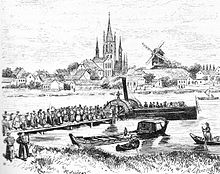Fruit trees
Obsttiene , sometimes also written Obsttine , describes a special barrel-like, wooden transport vessel for table grapes and fruit in the Werder (Havel) area .
history
A wooden vessel, called Tiene for short , was used in the Brandenburg town of Werder (Havel) until after the First World War . The wooden vats were usually on the back of fruit growers to the transport barges carried and on the Havel and the Spree primarily to the sale via stalls and markets in Berlin shipped. To commemorate this time, the former collection and loading point of the Tienen on the Föse, the western arm of the Havel, is now officially called Tienenplatz .
Tiene in viticulture
The term Tiene comes from wine press and was originally used in the Mark Brandenburg in the 16th and 17th centuries. Used in the 18th century for the wooden vats in which the grapes were treaded. The Werderans later transferred the term to the vessels in which they transported their table grapes and their fruit. The fruit-growing area around the island town of Werder has a long tradition that goes back to the fruit fields of the Cistercian monks in the Lehnin monastery , who owned Werder for a long time.
Capacity, dimensions
Depending on the type of fruit, the content of a Tiene was 3.5 to 4 kg or 7 liters. Vessels made of oak weighed 1.8 kilograms, those made of spruce 1.6 kilograms. The conical tienes were tied at the top with a linen cloth for shipping. In Werder (Havel) and the surrounding area, more than 200,000 tienes were in use around 1900, the production of which was very important for Werder's craft. There were three cooperatives on the island . It can be assumed that the cooperage came up in Werder / Havel as early as the 18th century and that the first tienes were made for the transport of fruit at the beginning of the 19th century. Before the bees were sold to the fruit growers , the cooper had them calibrated . The tienes were dried and then weighed and the weight was burned on the outside. A new 7 to 9 pound cherry stake cost sixty pfennigs in 1908. Raspberry bees held 50 to 60 pounds. The fruits were intended for industrial processing. Werder had a pioneering effect in terms of transport containers by being the first German growing area to introduce the chip basket around 1910 . With that, the Tiene very quickly lost its importance.
Tienen more interesting than Schinkel buildings (Fontane)
While walking through the Mark Brandenburg, Theodor Fontane remembers his way to school in Berlin , which took him every morning to the Werderschen stand between Friedrichsbrücke and the Herkulesbrücke, at its original location on Burgstrasse: “ Sometimes it happened that we did that Delayed "second meetings" of the Werderschen, from the lower tree, saw swimming up: large barges crowded with trees, while twenty Werder women sat on the rowing benches and vigorously moved their oars and their heads with their hats. [...] The air swam with a refreshing scent, and the dome structure of the upturned and stacked wooden rails interested us more than the Monbijou chest of drawers and, sadly, also the forest of columns in the Schinkelschen Neues Museum. "
literature
- Theodor Fontane, Walks through the Mark Brandenburg . Part 3. Havelland. (1st edition 1873.) Quotation from the edition of Nymphenburger Verlagshandlung, Munich 1971, Frankfurt / M., Berlin. Page 418. ISBN 3-485-00293-3 . Because of the many different editions of the note: Chapter Die Werderschen , 1st section.

